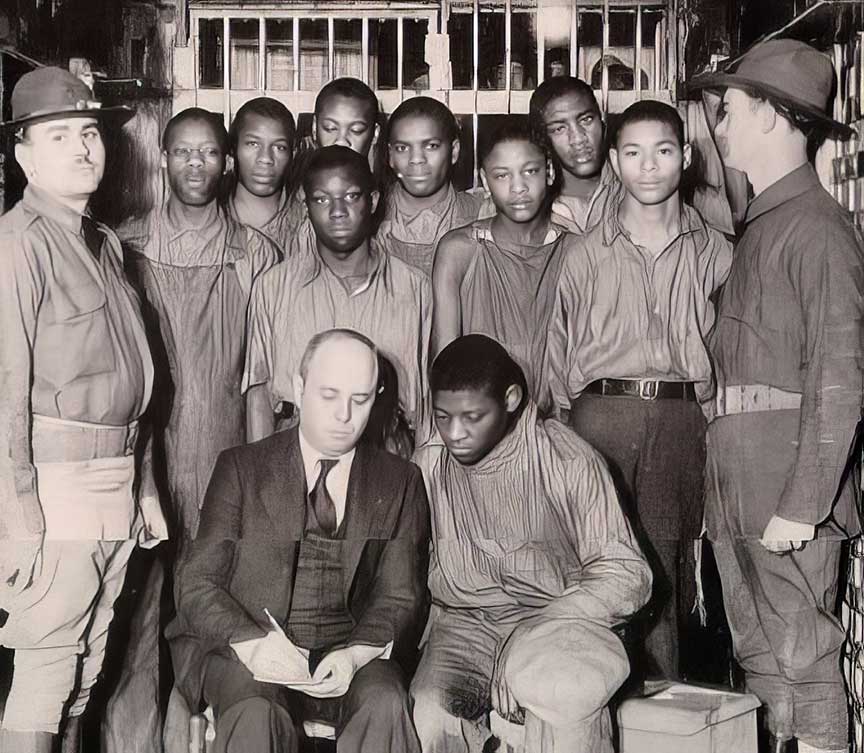1931 Scottsboro Trial

The Scottsboro Boys, with attorney Samuel Leibowitz, under guard by the state militia, 1932
Nine Black youths were convicted of raping two White women of questionable character in Scottsboro, Alabama. The case received national and international attention. By 1950 all were free. They were the lucky ones. Between 1882 and 1968, 3,446 Blacks were lynched in the South.
In 1931, nine Black youths were wrongfully accused and convicted of raping two White women of questionable character in Scottsboro, Alabama. The case received national and international attention, serving as a glaring reminder of the systemic oppression faced by African Americans. By 1950, all nine had been released, but their ordeal underscored the brutal reality of racial violence and injustice in the South, where between 1882 and 1968, 3,446 Blacks were lynched.
On March 25, 1931, a fight broke out between a group of Black and White youths riding a freight train through Alabama. The fight led to the arrest of nine Black teenagers: Clarence Norris, Charlie Weems, Haywood Patterson, Ozie Powell, Willie Roberson, Eugene Williams, Olen Montgomery, Andrew Wright, and Roy Wright. Two White women, Ruby Bates and Victoria Price, later accused the boys of raping them on the train. Despite the lack of credible evidence and the dubious character of the accusers, the boys were swiftly arrested and taken to Scottsboro, Alabama.
The Scottsboro Boys’ trials were a mockery of justice from the start. Within a mere two weeks of their arrest, the trials began. The boys were provided with inadequate legal representation, and the atmosphere in the courtroom was charged with racial hostility. Despite the weak evidence, including the medical testimony that did not support the women’s claims, all but one of the boys were convicted and sentenced to death by all-White juries. The youngest, Roy Wright, was spared the death penalty due to his age but was still found guilty.
The Scottsboro case quickly garnered widespread attention. The Communist Party USA and the International Labor Defense (ILD) took up the boys’ cause, providing legal representation and mobilizing public opinion. The case became a symbol of the broader struggle for racial equality and justice, drawing support from various civil rights organizations and prominent individuals. Protests and rallies were held across the United States and even abroad, demanding justice for the Scottsboro Boys.
The legal battle for the Scottsboro Boys’ freedom was long and arduous. In 1932, the U.S. Supreme Court overturned the initial convictions in Powell v. Alabama, ruling that the defendants had been denied effective counsel. The case was retried multiple times, and each retrial was marred by the same racial prejudice and disregard for due process. In 1935, the Supreme Court intervened again in Norris v. Alabama, ruling that Blacks had been systematically excluded from the juries, violating the defendants’ right to a fair trial.
Despite these legal victories, the Scottsboro Boys remained imprisoned for years. Ruby Bates, one of the accusers, eventually recanted her testimony, admitting that the rape accusations were fabricated. This revelation, along with the tireless efforts of the boys’ defense teams and supporters, slowly began to sway public opinion. However, it was not until the late 1940s and early 1950s that the Scottsboro Boys were finally released. Some were paroled, while others had their charges dropped. By 1950, all nine had regained their freedom, but the scars of their ordeal remained.
The plight of the Scottsboro Boys was a stark reminder of the pervasive racism that permeated the legal system and society at large. Between 1882 and 1968, 3,446 Blacks were lynched in the South, victims of racial terror and mob violence. These lynchings were often carried out with impunity, as the perpetrators were rarely held accountable.
\
 >
>